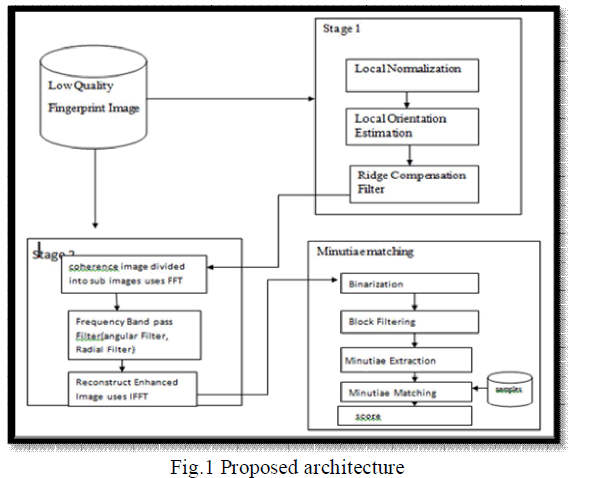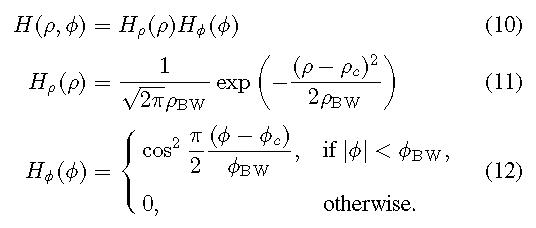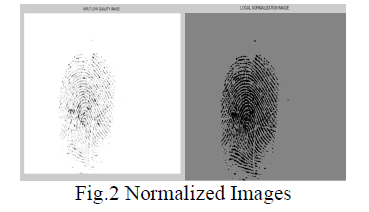ISSN ONLINE(2320-9801) PRINT (2320-9798)
ISSN ONLINE(2320-9801) PRINT (2320-9798)
M.Jayalakshmi1, P. Robert2
|
| Related article at Pubmed, Scholar Google |
Visit for more related articles at International Journal of Innovative Research in Computer and Communication Engineering
The recital of the fingerprint recognition techniques trusts comprehensively on the eminence of the input fingerprint images. Fingerprint images are frequently of low quality because of the perspectives of the image acquisition procedure. The imperfection of crumple structures from each separable are not archetypally well defined and it is very hard to enhance the contexts of these images. In proposed scheme, enhancement is conceded out two junctures. Algorithm first improves the images in the spatial domain with a spatial crumple compensation filter and then enhances the images in the frequency domain. The limits are crumple direction and frequency of the frequency band pass filters are predictable from the original image and the first-stage enhanced image. The output of the second stage fingerprint images are matches with templates in the public databases and produce the minutiae matching scores.
Keywords |
| Fingerprint enhancement, learning, fingerprint recognition system, image normalization, two-stage filtering. |
INTRODUCTION |
| Biometrics designated as the knowledge of identifying a distinct based on his or her physical or negotiating behaviors is beginning to gain acceptance as a legitimate method for the fortitude of an individual’s identity [1]. Biometric systems [46] have now been positioned in various saleable noncombatant and uncontrolled requests as a means of establishing identity in the human machine systems, cybernetics, and [3] computational acumen. In [2] the authors designated an innovative multimodal biometric identification system that is based on fingerprints and iris in a reliable and dependable way, according to a specific target application for security applications. In [3], the authors providing a synopsis of biometrics and deliberated some of the prominent research issues that need to be addressed for making biometric technology an operative tool. Among everything the biometric pointers fingerprints is one of the premier levels of dependability and have been extensively used by forensic experts in criminal inquiries [4]. Fingerprint gratitude has emerged as one of the most reliable means of biometric authentication because of its universality, uniqueness, Perpetuity and precision. But the recital of fingerprint recognition techniques trusts heavily on the quality of the input fingerprint images. Fingerprint images are frequently of low quality, because of the contexts of the image-acquisition process. In general noise from input devices can be easily eliminated using simple filters though the inadequacy of crumple structures from each individual are not typically well defined, and it is very hard to enhance the contexts of these images. The distinction of a fingerprint image may be poor or significantly different because of various factors, such as wetness and dryness, pressure strength, smears, and so on, which lead to different types of degradation in fingerprint images. For example, certain crumples are not connected even if they should be and some parallel crumples are not well separated. Thus finger print enhancement methodologies are needed to deal with all of these influences. Normally speaking, fingerprint gratitude algorithms are unevenly [4] categorized into two classes: minutiae-based and image-based [7] methods [8]–[10], which primarily use minutiae [5] info or a orientation point along with a number of crumple attributes for appreciation The wrong elevation operational information can be fatal to both classes of recognition algorithms since it can change the information of the minutiae points and reference points, and it may also cause some errors in feature extraction. To reduce the possibility of [12] recognition error, a robust enhancement algorithm is required, especially for low-quality fingerprint images. Because of the no stationary nature of the fingerprint image, the complex ridge structures are not easily distinguished. A mainstream of the current enhancement techniques [11] [31] are proposed in recent years, [19] and some are based on the use of spatial-domain methods, such as contextual filters [11] or Gabor filters [14], anisotropic filters [15], compensation filters [16], image scale based filters [18] directional filters and enduring alignment modeling. The spatial domain methods take in spatial difficulty of the image with filter masks which is simple [17] for operation. [20] [21] Other enhancement methods are based on using frequency domain method such as Log Gabor filters [23], directional Fourier filters [24], wavelets [25], discrete cosine transform [26], fast Fourier transform (FFT) [27], short-time Fourier transform (STFT) [31], and so on. Filters in the frequency domain can be used to calculate convolutions effectively from the entire image rather than from a small area of the filtered point in the spatial domain; therefore, this leads to more effective noise reduction in the filtered image. However, these research studies are focused on the design of appropriate filters trendy 1 stage any of the spatial or the frequency domain to contest the right local [30] orientation or frequency of the crumples and use the information to improve the ridge structure in fingerprint images. Crumple structures that are affected by unusual input contexts can be very complicated, and any improvement should be attempted with a very delicate approach. Besides, using only one-stage processing any in the spatial domain or the frequency domain for fairly low-quality fingerprint image enhancement is not enough to meet the contexts of a high recital verification system. Moreover, enhancement needs to be conducted in order to enhance the fingerprint image completely. In order to overcome the shortcomings of the existing algorithms on the fairly poor fingerprint images with cracks and scars, dry skin, or poor ridges and valley contrast ridges. Two step preparation to enhance the low-quality fingerprint image in both the spatial domain and the frequency domain based on the learning from the images. Spatial domain uses ridge compensation filter and frequency domain uses band pass filter as a radial filter and apply angular filter in the coherence image. Minutiae extraction done by the block filter and minutiae matching score will be obtained based on the minutiae matching technique. The advantages of proposed method are as follows: 1. Reduce the computational complexity. 2. Minutiae matching score comparatively studied with cancelable biometrics. The features of this proposed method are as follows. |
| 1) Using a two-stage scheme to improve the low eminence fingerprint image in together spatial domain and the frequency domain based on the learning from the images. |
| 2) The first stage improvement scheme enhances the contrast of ridges and valleys and repairs the ridge structures very well in the low-quality images, and the second-stage filter will obtain the filters’ parameters from both the original image and the first-stage enhanced image instead of acquiring from the original image solely, thus helping in the next stage of enhancement. |
| 3) In the first-phase local normalization is used to reduce the variations in gray level values along ridges and furrows instead of using traditional global normalization. |
| 4) Using a local compensation filter to enhance the fingerprint image with a mask enhances the ridges’ pixels’ gray level values along the local ridge orientation, while reducing the gray-level values of nonridges’ pixels. |
| 5) In the second stage dispensation polar coordinates (ρ, φ) are used to express the filters as a separable function; the filters used remain distinguishable in the radial and angular domains individually. |
| 6) Using an exponential band pass filter as the radial filter, it has a desired steep attenuation in the bandwidth. |
| 7) Using local orientation and local frequency as the parameters’ estimation based on the learning from the images for fingerprint filter design. |
| 8) With this two stage augmentation algorithm, it will enhance fairly low-quality fingerprint image completely, thus help to deal with the various input contexts. |
ALLIED WORKS |
| Mortal experts consistently expenditure the background information of fingerprint images, such as crumple endurance and monotony to help in finding. These revenues the essential morphogenetic practice that created the ridges sees not to allow for irregular breaks in the ridges except at ridge endings. The efficiency of a programmed enhancement algorithm hangs on the scope to which they use the background information. Some filters for these enhancement tasks are classified either in the spatial domain or in the frequency domain. Conferring to the sorting of the filter the existing enhancement processing is unevenly classified into either spatial domain filtering. |
Spatial-Domain Filtering |
| The spatial domain techniques consist of spatial convolution of the image with filter masks which is simple for operation. For computational reasons, such masks must be small in the spatial extent. In the authors first [11] proposed the use of contextual filters for fingerprint image enhancement. They used an anisotropic smooth out kernel whose major axis was oriented parallel to the ridges. For effectiveness the filter was precomputed in sixteen ways. The filter increased the ridge contrast in a direction perpendicular to the ridges, while it performed smoothing in the direction of the ridges. In the writer’s upcoming the use [15] of an isotropic filter based on structure adaptive filtering. The planned filter has band pass filter characteristics and is effective in removing noise while preserving the local ridge frequency of the fingerprint image. |
 |
| The most popular approach to fingerprint enhancement, which was proposed in [12], is based on a directional Gabor filtering kernel. The algorithm uses a properly oriented Gabor kernel, which has frequency discriminating and orientation selective properties, to perform the enhancement. These properties allow the filter to be tuned to give maximal response to ridges at a specific orientation and frequency in the fingerprint image. However, unlike Fourier bases or discrete cosine bases, using Gabor elementary functions has the following problems: Gabor elementary functions do not form a tight frame; they are bi-orthogonal beginnings and there is no rigorously justifiable reason for choosing the Gabor kernel over other directionally selective filters, such as directional derivatives of Gaussians or steerable wedge filters [32]. More recent works that are based on reaction diffusion techniques can be found in [33] and [34]. |
PROPOSED SYSTEM |
| Affording to the exploration of the outdated prior works the current augmentation algorithms are not always satisfactory in enhancing low-quality fingerprint images. To overcome the demerits of these methods we propose a new and effective scheme in this paper for the enhancement of the images using two consecutive stages as exposed in Fig. 1. The algorithm first enhances the images in the spatial domain with a spatial ridge compensation filter and then enhances the images in the frequency domain. The parameters ridge direction and frequency for the frequency band pass filters are estimated from the original image and the first-stage enhanced image. The details are introduced as trails. |
Main Phase Improvement: Spatial Crumple Compensation Filter |
| The first stage performs ridge compensation along the ridges in the spatial field. This step enhances the fingerprint’s local ridges using the neighbor pixels in a small window with weighted mask along the orientation of the local bridges each pixel in the fingerprint is swapped with its weighted neighbor sampling pixels in a small window and with the controlled contrast parameters along the orientation of the local crumples. In the meantime the filter improves the gray level standards of crumples pixels along local crumple positioning while reducing the non-crumple pixels gray level values thus, it is able to connect the broken bars and remove the smears in the fingerprint image. Unlike the smoothing operation the compensation filter uses weighted constant values to control the contrast parameters. Although not completely enhancing the fingerprint, the processing enhances the ridge contrast and preserves the ridge structures. |
Subsequent Phase Improvement: Frequency Band pass Filter |
| Although the result of the first spatial filter surges the crumple difference in the vertical direction to the crumples this dispensation may haze the image as fine. Therefore a subsequent phase augmentation with a tuned band pass filter is proposed to enhance the fingerprint image serially. The frequency band pass filters used are separable in the radial and angular domains, respectively. The processing is able to enhance the fingerprint. Image both in the radial and the angular domains and enhance the ridges completely. As per a vital feature the parameters of the band pass filter are learnt from both the original image and the enhanced image. The enhancement of fingerprint images with band pass filters may take advantage of the regularity of the spatial structure by filtering the image with a position dependent band pass frequency filter whose pass band is matched everywhere with the local ridge orientation and local ridge frequency. Instead of using the entire image we apply the frequency filters to the blocks to utilize all of the local frequency and local orientation information. Previous research studies [27] must [28] [31] plunge sale band pass frequency filters for fingerprint image augmentation and they have been proven to be effective for enhancement. Yet these methods do have demerits, such as difficult parameters selection and non-effective filtering. To overcome these deficiencies we propose an improved scheme with an exponential band pass filter By polar coordinates (ρ, φ) to precise the filters as a separable function, the frequency band pass filters H(ρ, φ) used are separable in the radial and the angular domains singly and are given as follows: |
 |
| After the execution of a classy minutiae based method, the whole system will have better performance compared with the method that does not use the enhancement. |
EXPERIMENTAL RESULTS |
| We reconnoiter the experimental results in the first stage enhancement of the scheme in the fig.2 to get normalized images. This step takes input as a low quality fingerprint image and used to reduce the local variations and standardize the intensity distributions in order to consistently estimate the local orientation. The pixel wise process does not change the clarity of the ridge and furrow structures but reduces the variations in gray-level values along ridges and furrows, which facilitates the subsequent processing steps. img(i, j) is the gray-level value of the fingerprint image in pixel (i, j), nor img(i, j) is the normalizing value in pixel(i, j), and coeff is the amplificatory multiple of the normalized image. M is the mean of the sub image, and V is the variance of the sub image. M0 and V0 are the desired mean and variance values, respectively. In the experiments, we usedM0 = 128 and V0 = 128 × 128. |
 |
| A fingerprint verification method that uses tessellated invariant moment features [10] is verified mutual with the proposed method and some well-known enhanced algorithms. All of the experiments are based on the tessellation of region of interest with 16 tessellated cells, and each cell has 16 × 16 pixels the similarity measurement is the eigenvalue-weighted cosine distance. A good fingerprint enhancement is very important mainly for image based fingerprint [43] matchers, since the image based matcher depends on the accuracy of the reference point detection. We define a reference point as the point of the maximum curvature on the convex ridge [10] which is either a core singular point or a point with the maximum [44] curvature on the convex ridge if an image does not have a core point. If core points exist in a fingerprint, the core point on the convex ridge becomes a reference point. In case a fingerprint has two core points, one can automatically be selected as a reference point if it has a larger curvature than the other. For an arch type fingerprint with no core point, the point with the maximum curvature on the convex ridge becomes the reference point. It has been proven that it is more accurate for the detection of the reference point in the enhanced image than in the original image [16]. In order to show that the different enhancement methods benefit the reference point detection in the image-based method, we did the experiments on the FVC2004 four sub databases DB1_a– DB4_a, respectively. To evaluate the performance of the verification system, the false reject rate (FRR) and the false acceptance rate (FAR) are |
| Calculated: |
 |
| The equal error rate (EER) is used as a recital indicator. The EER indicates the point where the FRR and FAR are equal: |
 |
| Specifically, if the database has relative higher quality images, we may choose some traditional enhancement Algorithms to save the time otherwise we may choose the proposed augmentation algorithm to guarantee the higher gratitude accuracy. |
CONCLUSION AND FURTHER WORK |
| In this paper in order to overcome the deficiencies of the existing algorithms on the fairly poor fingerprint images with cracks and scars, dry skin, or poor crumples and valley contrast crumples an effective two-stage enhancement scheme in both the spatial domain and the frequency domain for low quality fingerprint images by learning from the images has been proposed in the theoretical way. Highlighting the augmentation of the low quality images, the main phase augmentation scheme has been designed to use the context information of the local ridges to connect or separate the ridges. In the subsequent phase processing, the filter is separable in the radial and angular domains, respectively. Its parameters have adequately been determined by the information of both the original image and the enhanced images of the first stage instead of acquiring from the original image solely. Thus, the proposed two phase system improves the fingerprint images significantly. As a future works the experimental results, the proposed scheme is able to handle various input contexts and achieves the best performance in combination with two designated corroboration algorithms. It is illustrious that the process has been done using MATLAB platform in our simulation. It can run fast by optimizing the code or run in C code. |
References |
|